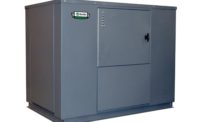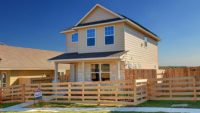With an energy output up to four times the energy input, it’s easy to understand why geothermal and air-source heat pumps are an increasingly popular choice for hydronic applications.
Benefits such as higher efficiencies and integrating heating and cooling capabilities make the use of heat pumps an attractive solution. To effectively operate these types of heat pumps in a hydronic application, a proper control strategy must be in place. Matching together the mechanical piping arrangement and the control strategy will ensure the entire system can be coordinated to seamlessly work together, improving performance and reliability.
Figure 1 shows a piping solution for a two-pipe heat-pump application that includes many typical loads seen in a system, including radiant floor or ceiling zones, fan coils, a backup boiler, DHW and some high temperature loads such as baseboards. This piping arrangement also can include cooling capability through the fan coils and through the radiant floor or ceiling. However, integrating heating and cooling together in a two-pipe system can be challenging because only heating or cooling can be supplied at any given point in time.
Today, heat-pump systems typically are installed with standalone thermostats that control the zone temperatures by turning on the zone valves. Independent setpoint controls are used to operate the heat pump to maintain the tank temperature. The challenge with this control strategy is the ability to create a proper interlock between the heating and cooling operation and to make sure the thermostats know when chilled water or hot water is available.
To create an interlock between heating and cooling, many contractors use summer/winter switches or outdoor temperature limits. This strategy requires additional wiring with isolation relays, which creates complexity in the wiring. A second interlock is required to ensure the thermostats know which water temperature is available. When a thermostat operates its zone to provide heating and the tank has chilled water, problems will occur.
Conquering challenges
Choosing an integrated control strategy will help address these common challenges. Using control logic to consider all system parts, a central control will coordinate the interaction between the zones, heat pump, DHW and the backup heat source to work together to improve overall system operation. Communicating thermostats that “talk” back to a central control help determine whether chilled or hot water is required.
The central control knows which zones have called for heating or cooling and determines which water temperature to supply. If the control determines heating is required, the central control will “tell” the cooling zones to remain off. Once all heating zones are satisfied and no longer require additional heat, the control may decide to provide chilled water to satisfy the cooling zones. This built-in control logic improves system efficiency, reliability and energy savings, while eliminating the need for all external wiring. This makes installation much simpler.
Another growing trend in heat-pump applications is radiant floor or ceiling cooling. In order to properly operate radiant cooling, humidity levels must be considered to prevent condensation on the floor or ceiling surfaces. An effective control strategy includes communicating thermostats with built-in humidity sensing capabilities. Humidity levels are measured and communicated to the central control allowing a minimum water temperature to be calculated based on the dew point. The control then supplies chilled water to the radiant surface at a temperature slightly above the dew point to avoid condensation.
Accurate temperature control is critical to ensure the water temperature supplied to the radiant surface is above the dew point. In the application (shown above), temperature control is temperature control is accomplished by using mixing through a variable-speed injection pump (P1). This is a standard pump operated at different speeds that injects chilled water into the radiant loop so the radiant surface satisfies a large portion of the sensible cooling load. To satisfy the latent cooling load, fan coils draw cooler chilled water temperatures directly from the tank. These fan coils also handle additional heating requirements throughout a building.
The trend to use heat pumps to maximize energy efficiency while heating or cooling a building continues to grow. Incorporating an integrated control strategy is as important as determining which equipment to install. Matching the control strategy to the mechanical installation will make an efficient heat pump system a simple reality. Not only does the communication between the thermostats and the central control allow for proper interlocking, but the entire system will work together to get the best performance out of any heat pump.
About the author: Greg Leupin, a mechanical engineer specializing in HVAC electronic controls, is a manager with tekmar Control Systems, a Watts Water Technologies company. With more than 18 years of experience, he is focused on teaching contractors and designers how to get the best performance out of their systems. He can be reached at customerservice@tekmarControls.com.




